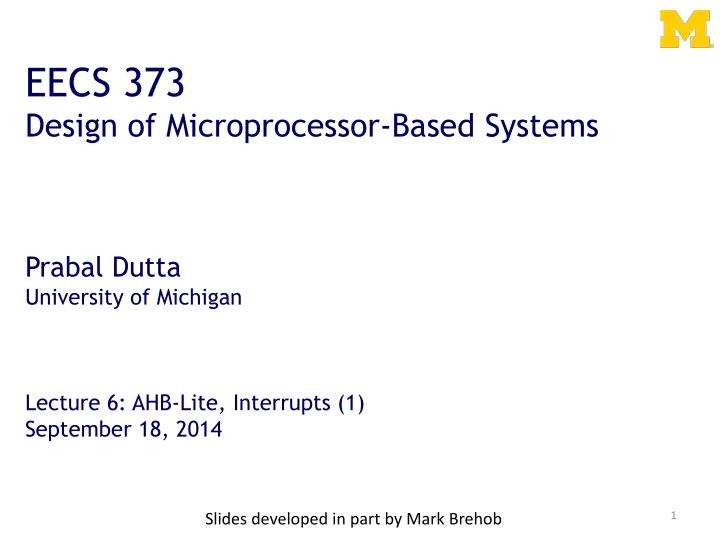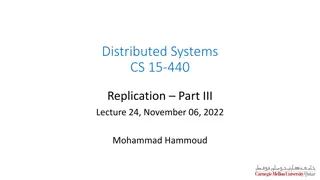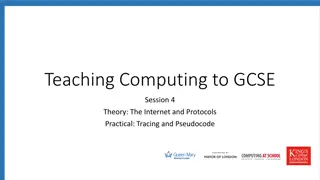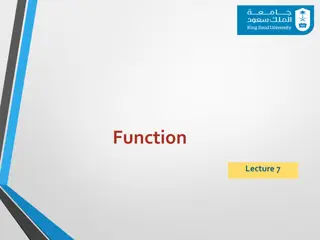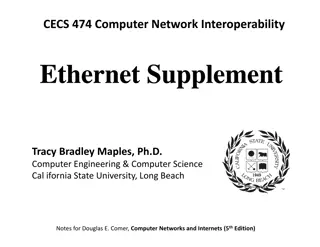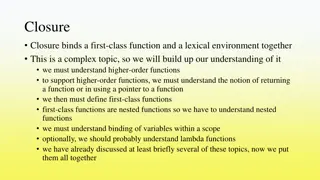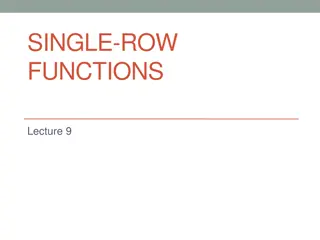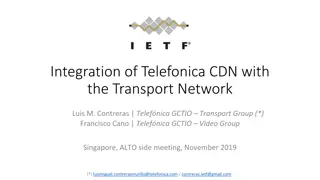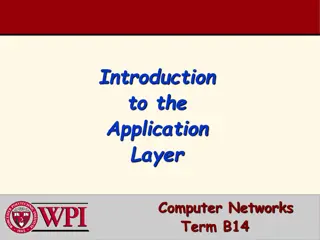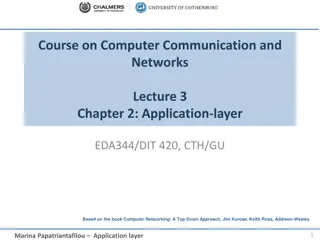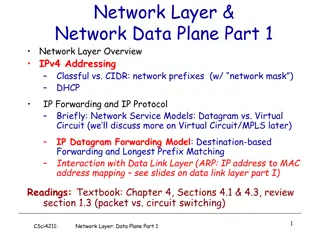Network Protocols: Types and Functions
Network protocols play a crucial role in governing communication between computers on a network. Explore different types such as HTTP, FTP, SMTP, Ethernet, and TCP/IP, each serving specific functions. HTTP and HTTPS facilitate web browsing, while FTP handles file transfers. SMTP is essential for email communication, and TCP/IP ensures reliable data transmission over networks.
Download Presentation

Please find below an Image/Link to download the presentation.
The content on the website is provided AS IS for your information and personal use only. It may not be sold, licensed, or shared on other websites without obtaining consent from the author.If you encounter any issues during the download, it is possible that the publisher has removed the file from their server.
You are allowed to download the files provided on this website for personal or commercial use, subject to the condition that they are used lawfully. All files are the property of their respective owners.
The content on the website is provided AS IS for your information and personal use only. It may not be sold, licensed, or shared on other websites without obtaining consent from the author.
E N D
Presentation Transcript
EECS 373 Design of Microprocessor-Based Systems Prabal Dutta University of Michigan Lecture 6: AHB-Lite, Interrupts (1) September 18, 2014 1 Slides developed in part by Mark Brehob
Today Announcements ARM AHB-Lite Start on interrupts
Announcements HW2 assigned; Due on 9/23 Questions Synchronizers Why separate read/write busses on APB?
Today Announcements ARM AHB-Lite Start on interrupts
Advanced Microcontroller Bus Architecture (AMBA) - Advanced High-performance Bus (AHB) - Advanced Peripheral Bus (APB) AHB High performance Pipelined operation Burst transfers Multiple bus masters Split transactions APB Low power Latched address/control Simple interface Suitable of many peripherals 5
AHB-Lite supports single bus master and provides high-bandwidth operation Burst transfers Single clock-edge operation Non-tri-state implementation Configurable bus width 7
AHB-Lite bus master/slave interface Global signals HCLK HRESETn Master out/slave in HADDR (address) HWDATA (write data) Control HWRITE HSIZE HBURST HPROT HTRANS HMASTLOCK Slave out/master in HRDATA (read data) HREADY HRESP 8
AHB-Lite signal definitions Global signals HCLK: the bus clock source (rising-edge triggered) HRESETn: the bus (and system) reset signal (active low) Master out/slave in HADDR[31:0]: the 32-bit system address bus HWDATA[31:0]: the system write data bus Control HWRITE: indicates transfer direction (Write=1, Read=0) HSIZE[2:0]: indicates size of transfer (byte, halfword, or word) HBURST[2:0]: indicates single or burst transfer (1, 4, 8, 16 beats) HPROT[3:0]: provides protection information (e.g. I or D; user or handler) HTRANS: indicates current transfer type (e.g. idle, busy, nonseq, seq) HMASTLOCK: indicates a locked (atomic) transfer sequence Slave out/master in HRDATA[31:0]: the slave read data bus HREADY: indicates previous transfer is complete HRESP: the transfer response (OKAY=0, ERROR=1) 9
Key to timing diagram conventions Timing diagrams Clock Stable values Transitions High-impedance Signal conventions Lower case n denote active low (e.g. RESETn) Prefix H denotes AHB Prefix P denotes APB 10
Basic read and write transfers with no wait states Pipelined Address & Data Transfer 11
Read transfer with two wait states Valid data produced Two wait states added by slave by asserting HREADY low 12
Write transfer with one wait state Valid data held stable One wait state added by slave by asserting HREADY low 13
Wait states extend the address phase of next transfer Address stage of the next transfer is also extended One wait state added by slave by asserting HREADY low 14
Transfers can be of four types (HTRANS[1:0]) IDLE (b00) No data transfer is required Slave must OKAY w/o waiting Slave must ignore IDLE BUSY (b01) Insert idle cycles in a burst Burst will continue afterward Address/control reflects next transfer in burst Slave must OKAY w/o waiting Slave must ignore BUSY NONSEQ (b10) Indicates single transfer or first transfer of a burst Address/control unrelated to prior transfers SEQ (b11) Remaining transfers in a burst Addr = prior addr + transfer size 15
A four beat burst with master busy and slave wait Master busy indicated by HTRANS[1:0] One wait state added by slave by asserting HREADY low 16
Controlling the size (width) of a transfer HSIZE[2:0] encodes the size The cannot exceed the data bus width (e.g. 32-bits) HSIZE + HBURST is determines wrapping boundary for wrapping bursts HSIZE must remain constant throughout a burst transfer 17
Controlling the burst beats (length) of a transfer Burst of 1, 4, 8, 16, and undef HBURST[2:0] encodes the type Incremental burst Wrapping bursts 4 beats x 4-byte words wrapping Wraps at 16 byte boundary E.g. 0x34, 0x38, 0x3c, 0x30, Bursts must not cross 1KB address boundaries 18
An eight beat incrementing burst (INCR8) using half-word transfers 22
Multi-master AHB-Lite requires a multi-layer interconnect AHB-Lite is single-master Multi-master operation Must isolate masters Each master assigned to layer Interconnect arbitrates slave accesses Full crossbar switch often unneeded Slaves 1, 2, 3 are shared Slaves 4, 5 are local to Master 1 24
Today Announcements ARM AHB-Lite Start on interrupts
Interrupts Merriam-Webster: to break the uniformity or continuity of Informs a program of some external events Breaks execution flow Key questions: Where do interrupts come from? How do we save state for later continuation? How can we ignore interrupts? How can we prioritize interrupts? How can we share interrupts? 26
I/OData Transfer Two key questions to determine how data is transferred to/from a non-trivial I/O device: 1. How does the CPU know when data is available? a. Polling b. Interrupts 2. How is data transferred into and out of the device? a. Programmed I/O b. Direct Memory Access (DMA)
Interrupts Interrupt (a.k.a. exception or trap): An event that causes the CPU to stop executing the current program and begin executing a special piece of code called an interrupt handler or interrupt service routine (ISR). Typically, the ISR does some work and then resumes the interrupted program. Interrupts are really glorified procedure calls, except that they: can occur between any two instructions are transparent to the running program (usually) are not explicitly requested by the program (typically) call a procedure at an address determined by the type of interrupt, not the program
Two basic types of interrupts (1/2) Those caused by an instruction Examples: TLB miss Illegal/unimplemented instruction div by 0 Names: Trap, exception
Two basic types of interrupts (2/2) Those caused by the external world External device Reset button Timer expires Power failure System error Names: interrupt, external interrupt
How it works Something tells the processor core there is an interrupt Core transfers control to code that needs to be executed Said code returns to old program Much harder then it looks. Why?
is in the details How do you figure out where to branch to? How to you ensure that you can get back to where you started? Don t we have a pipeline? What about partially executed instructions? What if we get an interrupt while we are processing our interrupt? What if we are in a critical section?
Where If you know what caused the interrupt then you want to jump to the code that handles that interrupt. If you number the possible interrupt cases, and an interrupt comes in, you can just branch to a location, using that number as an offset (this is a branch table) If you don t have the number, you need to poll all possible sources of the interrupt to see who caused it. Then you branch to the right code
Get back to where you once belonged Need to store the return address somewhere. Stack might be a scary place. That would involve a load/store and might cause an interrupt (page fault)! So a dedicated register seems like a good choice But that might cause problems later
Snazzy architectures A modern processor has many (often 50+) instructions in-flight at once. What do we do with them? Drain the pipeline? What if one of them causes an exception? Punt all that work Slows us down What if the instruction that caused the exception was executed before some other instruction? What if that other instruction caused an interrupt?
Nested interrupts If we get one interrupt while handling another what to do? Just handle it But what about that dedicated register? What if I m doing something that can t be stopped? Ignore it But what if it is important? Prioritize Take those interrupts you care about. Ignore the rest Still have dedicated register problems.
Critical section We probably need to ignore some interrupts but take others. Probably should be sure ourcode can t cause an exception. Use same prioritization as before. What about instructions that shouldn t be interrupted?
Our processor Over 100 interrupt sources Power on reset, bus errors, I/O pins changing state, data in on a serial bus etc. Need a great deal of control Ability to enable and disable interrupt sources Ability to control where to branch to for each interrupt Ability to set interrupt priorities Who wins in case of a tie Can interrupt A interrupt the ISR for interrupt B? If so, Acan preempt B. All that control will involve memory mapped I/O. And given the number of interrupts that s going to be a pain in the rear. 38
